This project examines how we can make AI that's more inclusive, so that diverse people feel represented in the AI they interact with. This page narrates each phase of this work.
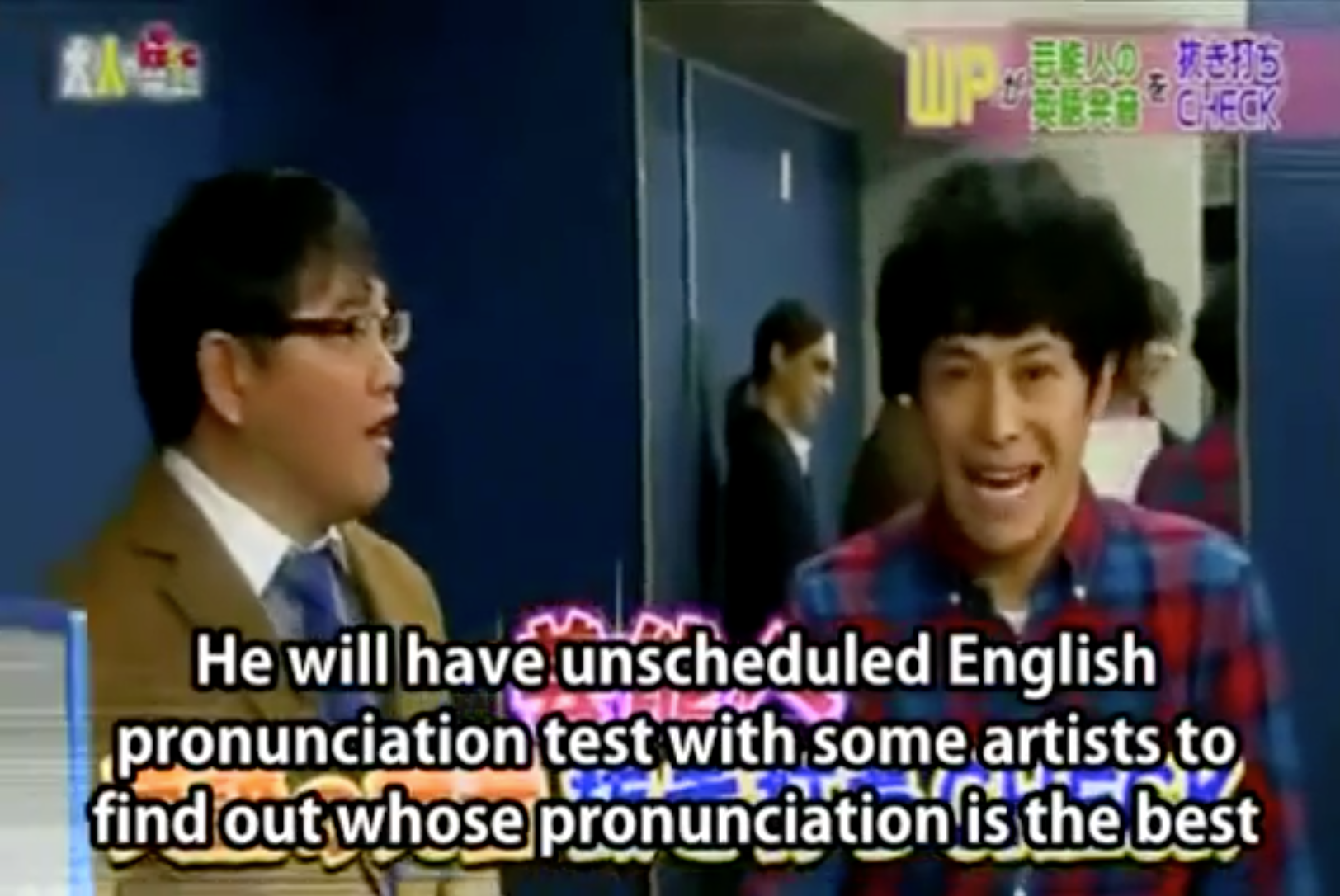
I first had the idea for this project when I saw a video on YouTube that has now been taken down. It's subtitled into English (see screenshot) from a Japanese game show that's loosely based on learning English. In this recurring segment (generously--and presumably illegally--uploaded for our viewing pleasure), the host wheels around a gigantic phone and surprises celebrities with an "English pronunciation test." The celebrities say one word in English to Siri, like "alarm," and if she recognizes the word, they win the round. If she doesn't, they have to keep trying and may lose the match. I was fascinated by how this segment sets up Siri as the judge of English, the perfect listener and speaker. There's a lot of potential in these segments. For now, my interest is in how Siri ends up helping to create the identities of the people on the show. This is visible in the title that the poster used: "Funny When Japanese Try to Speak English With Siri! So Hilarious!" In this title, the celebrities' interaction with Siri makes their Japanese identity relevant and labels the people as funny. Siri marks them as Japanese and as humorously incompetent at speaking English.
As I kept thinking about this interaction, I realized that the interactions people have with Siri might go beyond just constructing a national identity. People were potentially being positioned with a variety of identities. So I did a set of searches based on protected classes and found a whole range of parody videos where people's identity was front and center. I set a floor of 90,000 views for each video, with a few exceptions, marked with an asterisk below. Together, these videos form a corpus of crowdsourced ideas about identity, diversity, inclusion, and AI.
Crowdsourced ideas about identity and Siri (and view count upon corpus collection, July 2017):
-
Race/Ethnicity
- Mexican GPS | Rudy Mancuso (4,655,231)
- racist siri (1,155,865)
- _Martin_and_Siri__-_Gabriel_Iglesias_-_Standup_Revolution.mp4 (doing the stand-up bit "Black Siri") (505,483)
- If Siri Was MEXICAN [Part 1] (269,482)
- Black Siri (209,032)
- If Siri Was MEXICAN [Part 2] (144,110)
- Black Siri aka Siriqua (103,465)
- If Siri Was MEXICAN [PART 3] (66,715*)
-
Sexual Orientation
- Coming Out to Siri… (1,092,295)
- IF SIRI WAS GAY!! (295,760)
- iGay (iPhone Siri parody) (209,139)
- iGay (Siri Parody) (107,860)
-
Religion
- iPhone Siri Converts To Islam (2,557,602)
- TESTING THE FAITH OF IPHONE 7 SIRI - SURPRIZING ANSWER (2,187,009)
- ZaidAliT - Muslim Siri (310,912)
- Mormon Siri (41,242*)
- The Jewish Siri (39,997*)
-
Accent/Nationality
- Introducing the Iphone 5c and 5s (5,209,031)
- Robin Williams' Siri Impression (4,703,327)
- Apple Scotland - iPhone commercial for Siri (3,401,973)
- Funny When Japanese Try To Speak English With Siri! So Hilarious! (current link reposted; original subtitler's account got deleted. See also parts 2, 3, 4, 5, 6, 8, 9, 10, and 12) (2,066,376-97,150)
- iPhone has problems with Scottish accents (904,391)
- Hawaiian Pidgin English | Siri vs Hawaiian Pidgin (683,754)
- Nonna Paola Tries To Ask Siri 'The In Italy' On Her iPhone [Full Video] (414,826)
- Siri Vz Scottish Accent (141,995)
- HAWAIIAN PIDGIN SIRI (135,424)
- Stuff Hyderabadi Moms Say to Siri: with English subtitles (93,285)
Some of these videos are pretty stereotypical, but they're all done by people of that identity, with a clear sense of fun and lightheartedness. These identity-based variants of Siri seem like a promising, user-based way to understand how marginalized people are viewing their interactions with voice-driven AI. Compared to other parodies of Siri, like Trump Siri or Justin Bieber Siri, these seem directed at Siri treating the diverse creators of the parodies appropriately.

After I conceived of the project, I was accepted to the KairosCamp Digital Publishing Institute, a 2-week NEH-funded workshop for digital humanities projects led by Cheryl Ball, David Rieder, Madeleine Sorapure, and Doug Eyman. While there, I especially learned from them some technical aspects of creating a workflow: how to use git to maintain website files, how to test pages before they go live with http-server, how to prototype my videos using PowerPoint slides, how to think about accessibility and fair use in video projects, and how to handle revision in a multimedia writing project.
The video below records my short presentation to the other participants of what I
learned at KairosCamp. It includes a clip from the beginning of my first prototype for the
video series:
At the same time, I was working on learning video-editing chops as part of
creating a YouTube channel for emerging activists. I had learned to use Final
Cut Pro X, and had worked on getting some quality recording equipment (hence my
really nicely recorded voice in the video above, except for some mystery
scratchiness). This also helped me gain the skills to do a screen-based creative
media project.
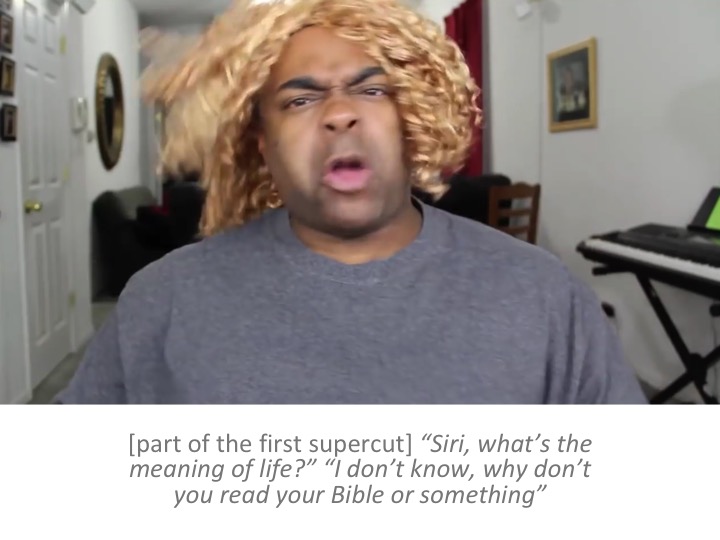
In Fall 2017 I was able to complete my first full storyboarded prototype. This prototype divided the project into 5 videos:
- An introduction that described the size, scope, and timing of the crowdsourced videos;
- A lay explanation of identity construction, especially how unequal power relations (like between marginalized people and voice-driven AI) makes identity construction fraught;
- A list of all the crowdsourced ideas for how Siri could talk differently to adopt an alternative identity;
- A critique of the actual Siri's race-blindness (and sexual orientation-blindness, and religion-blindness and nationality-blindness), on the basis that the universality of identity-blindness ends up adopting a straight, white, unaccented, nonreligious speaker identity; and finally,
- An exploration of how people in the original videos resisted this straight, white, unaccented, nonreligious Siri.
The project has simplified considerably since this prototype, including taking out the 5th video completely and reformulating some of the ideas in the others. Specifically, I thank Samantha Finkelstein for her insight that the crowdsourced ideas were less about re-imagining Siri's identity, and more about affirming the identity of the YouTube creators (and their audiences). This has lent itself to the current framing of the project: Making Siri More Like Us. The emphasis has shifted to how people change Siri in order to see themselves represented in AI.
At this stage, I was only able to list all of the characteristics that people's revised Siri displayed. The storyboard somewhat optimistically envisioned a supercut of each of those lines, which would in actuality be completely infeasible timewise. However, these lists are still helpful for thinking about themes that recur through the videos overall. (Abbreviations in the lists correspond to the videos linked above.)

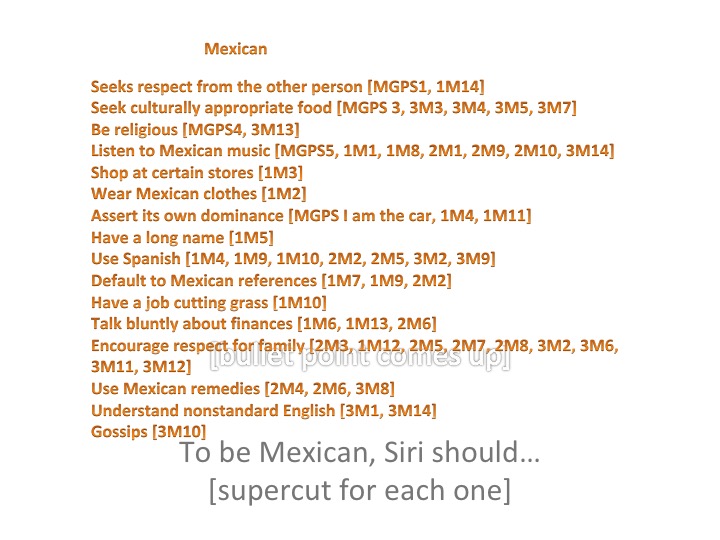
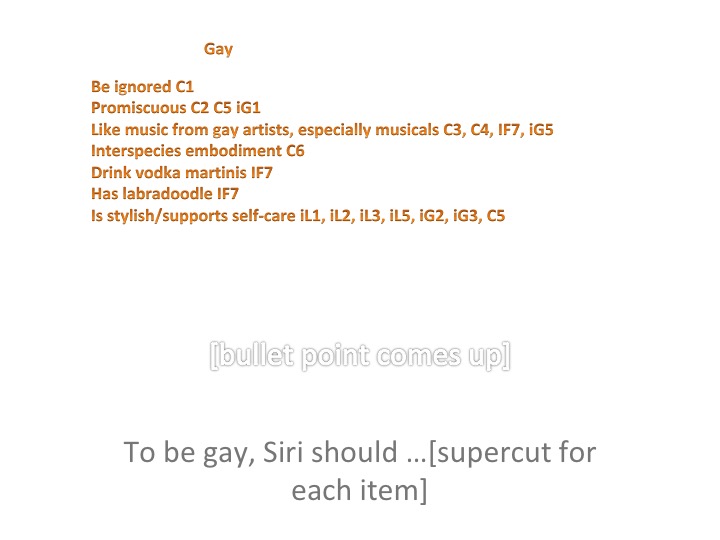

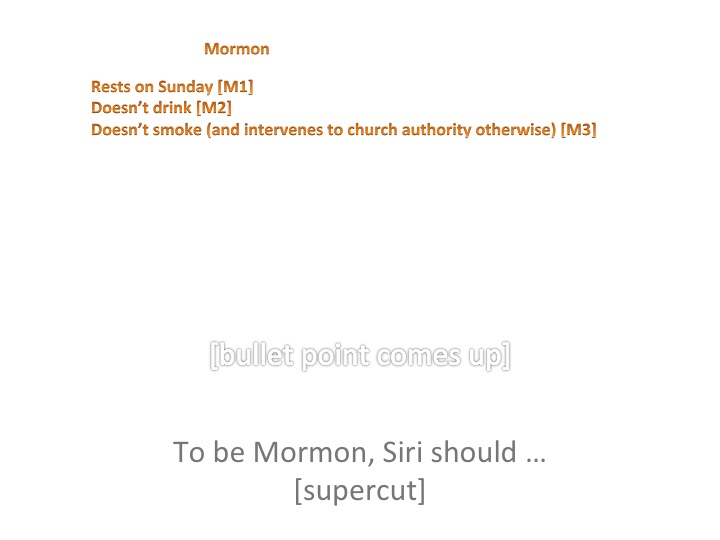

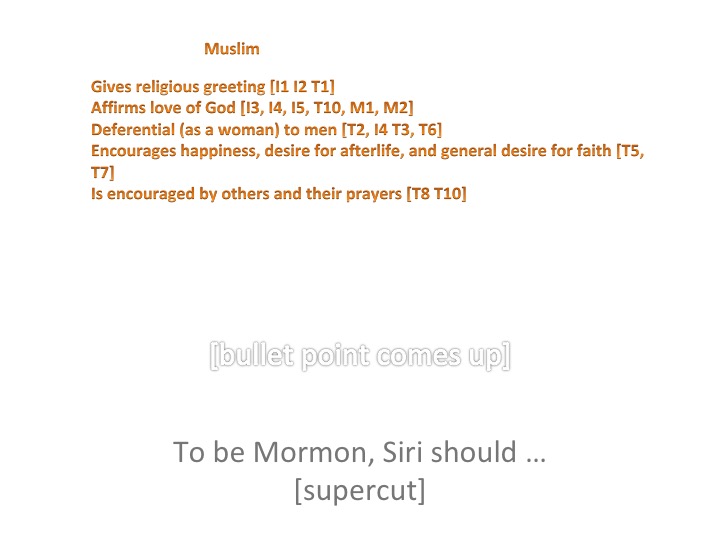
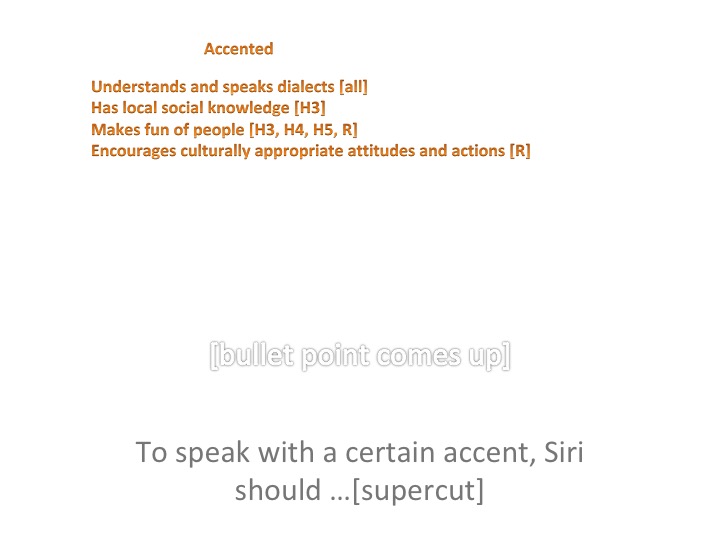
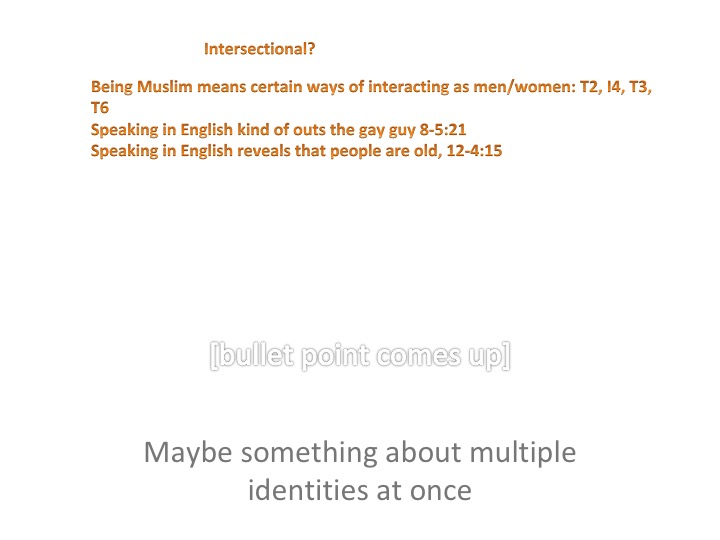
In other words, in the storyboarding it repeats that in order to "be" a certain identity, "Siri should..." But I've come to see these recommendations more as things Siri could say in order to talk "to" people of that identity, to make them feel comfortable and seen.

In spring 2018, I presented this project at the Computers and Writing conference in Fairfax, VA. The format, of being part of an open time right at the beginning of the conference, was immensely helpful, and I'm grateful for the feedback I received. In particular, some of the attendees mentioned that this project could be useful to them in their work with college students. I see this project being helpful to a variety of people.
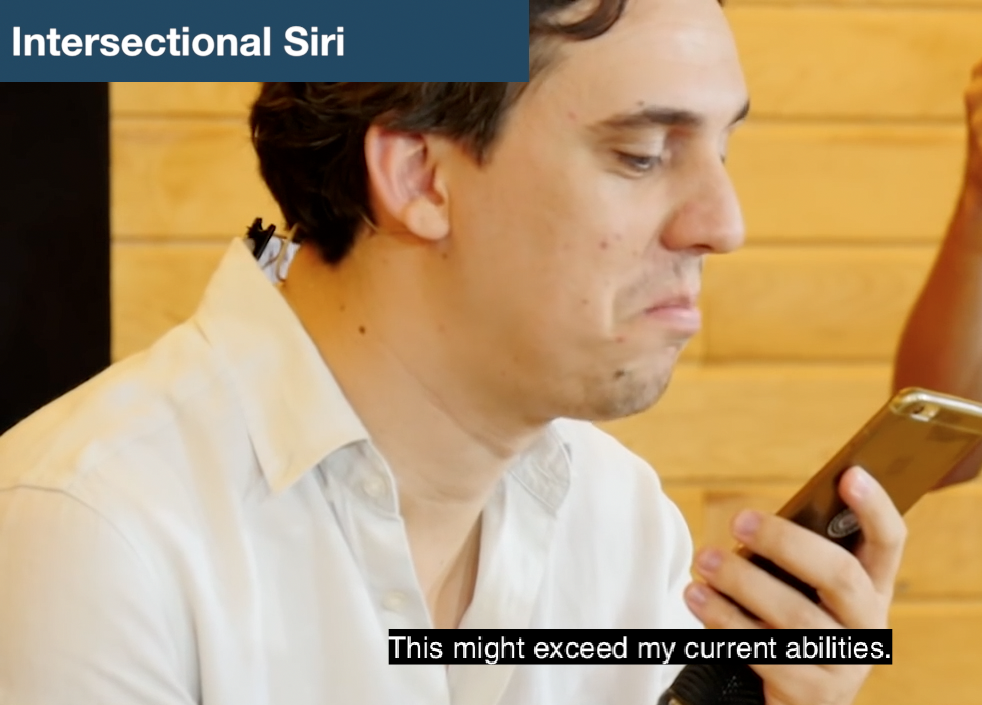
When I came back to the project, it solidified into two complementary pieces: how the YouTube creators reimagine Siri, and how they critique Siri. Thus, I decided to structure the project around these two, giving each one a video around 20 minutes long. I also decided to accompany the videos with an in-line transcript and linked notes. It was a difficult workflow to manage: there was what I wanted the video to say, what the video actually said, what the webtext said the video said, and what the notes linked to. I'm happy with it and I'm looking forward to receiving feedback from reviewers, but I'm also happy to be done! For a sneak peek at the finished webtext itself, see the submitted version.